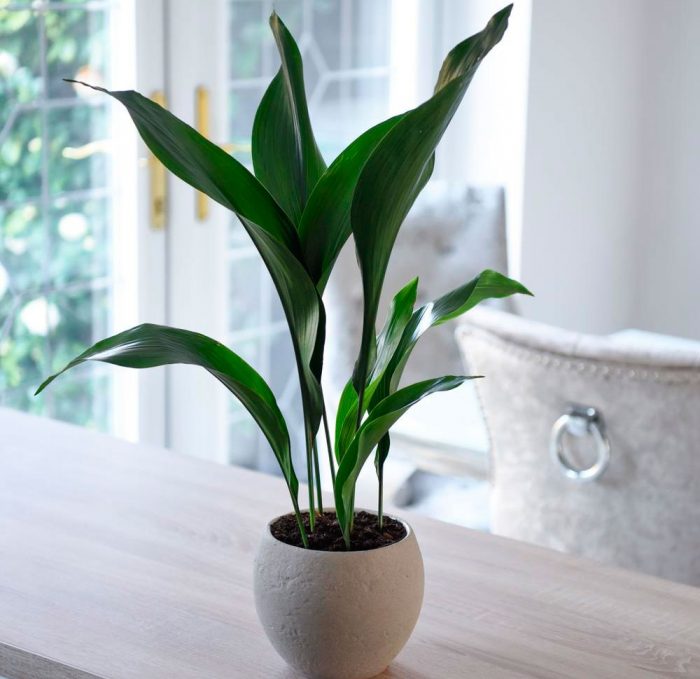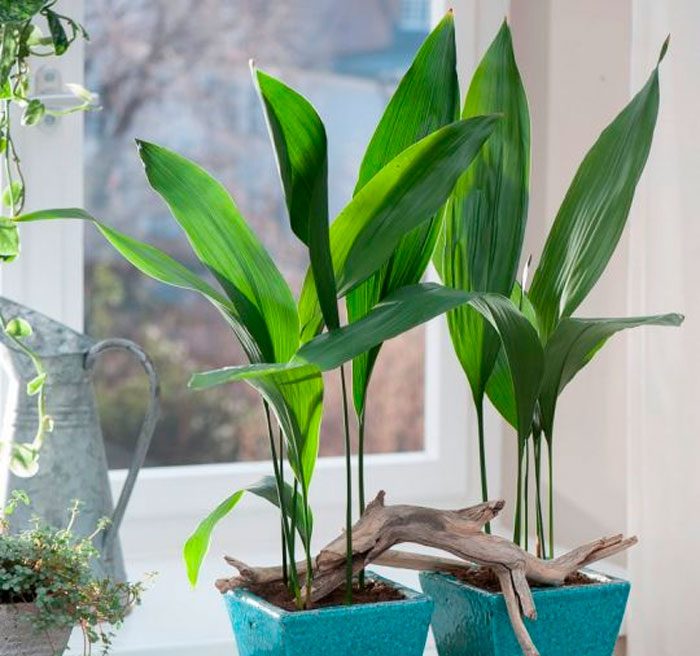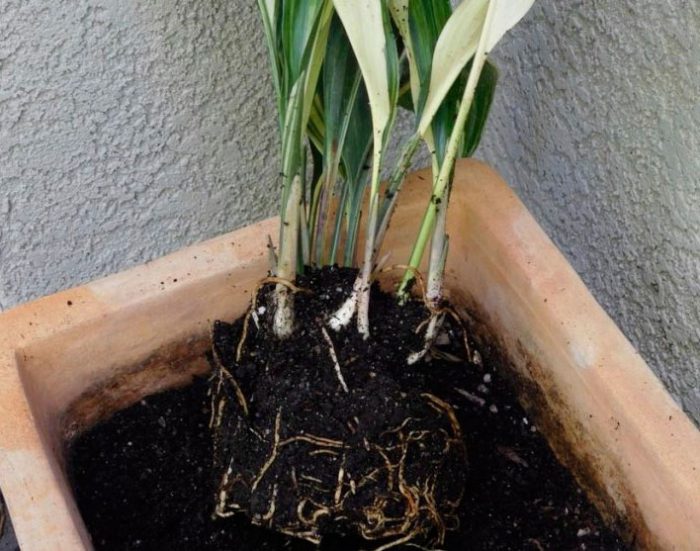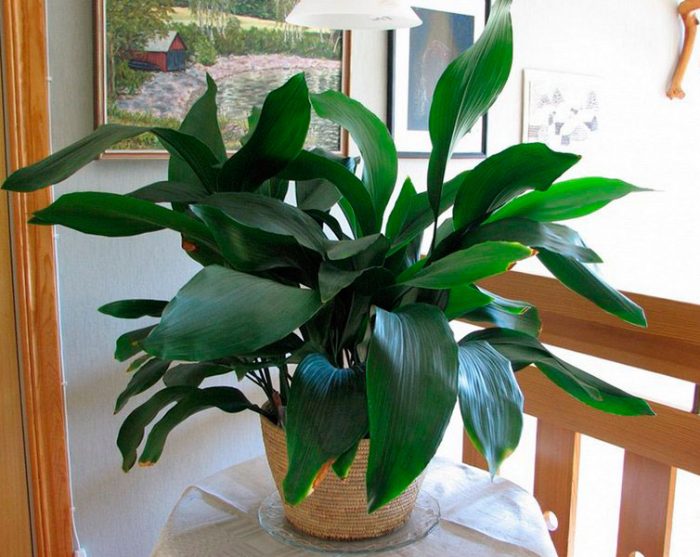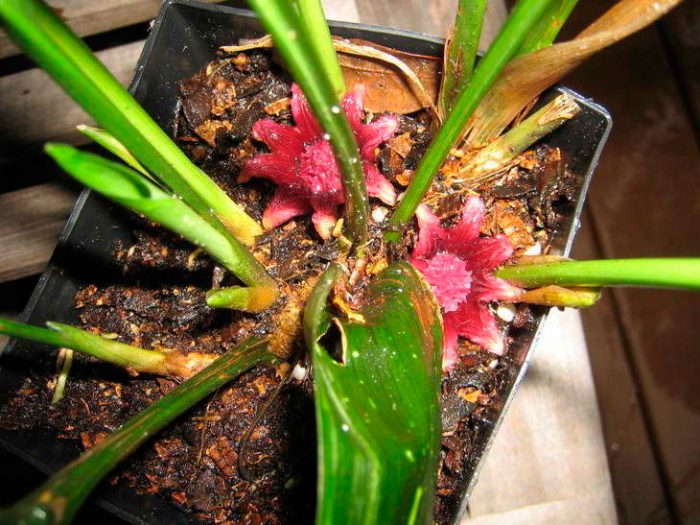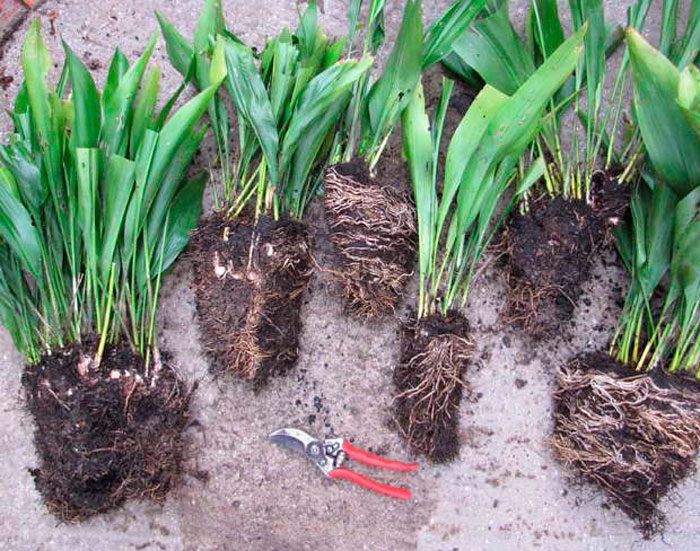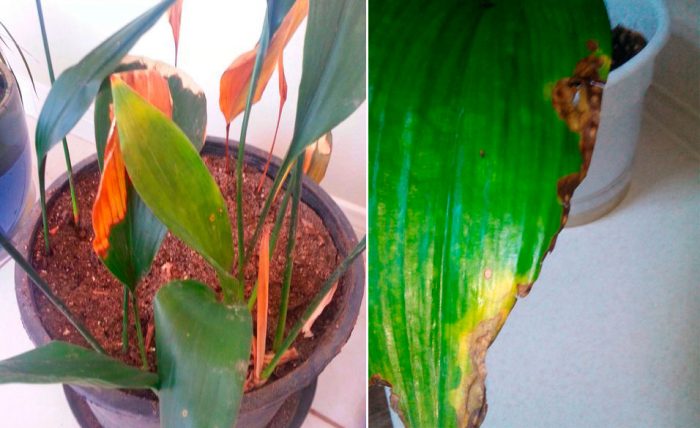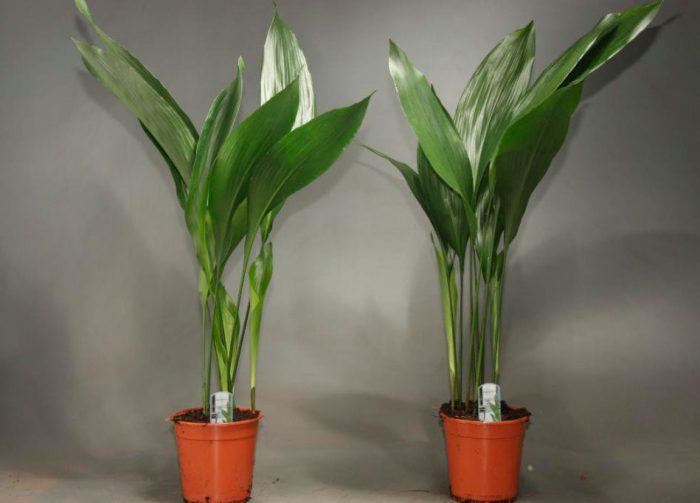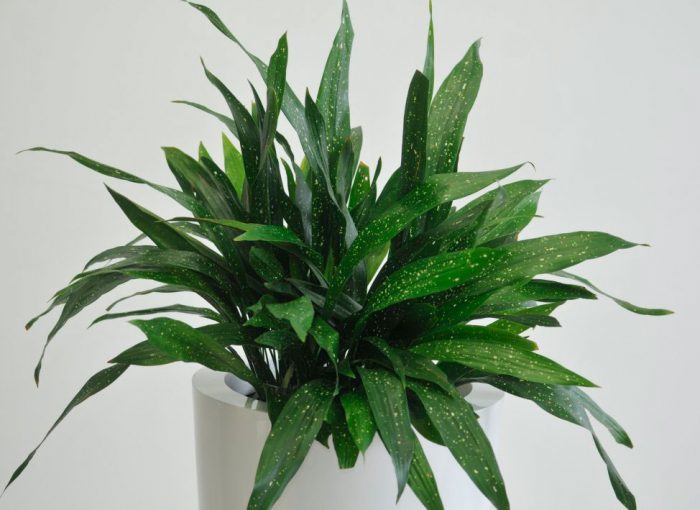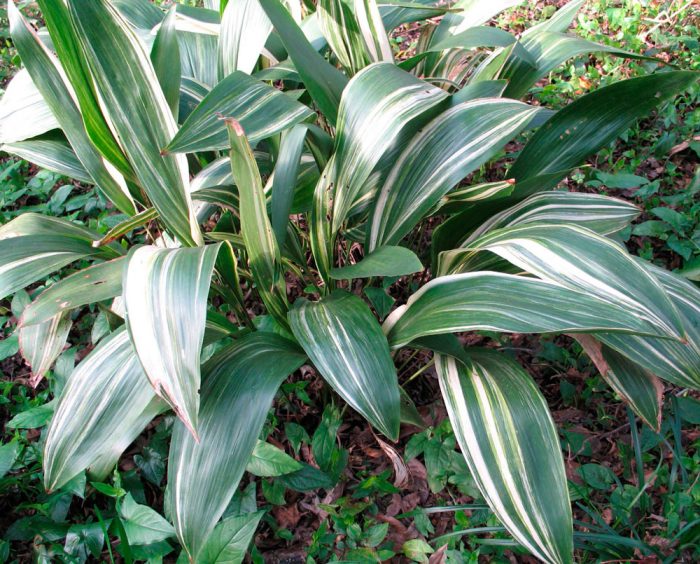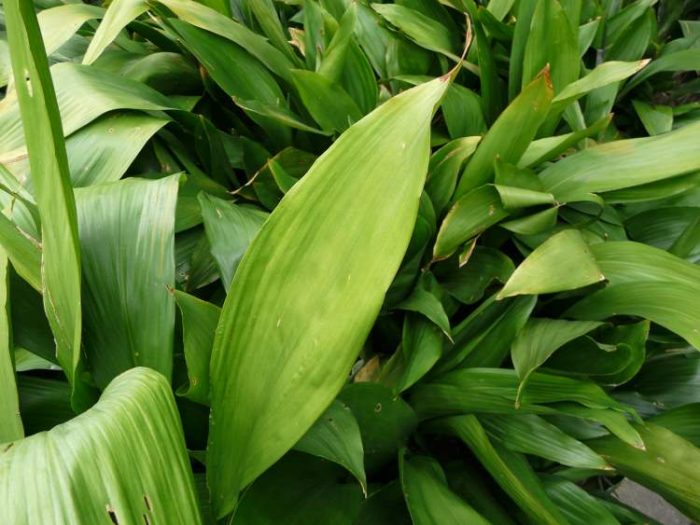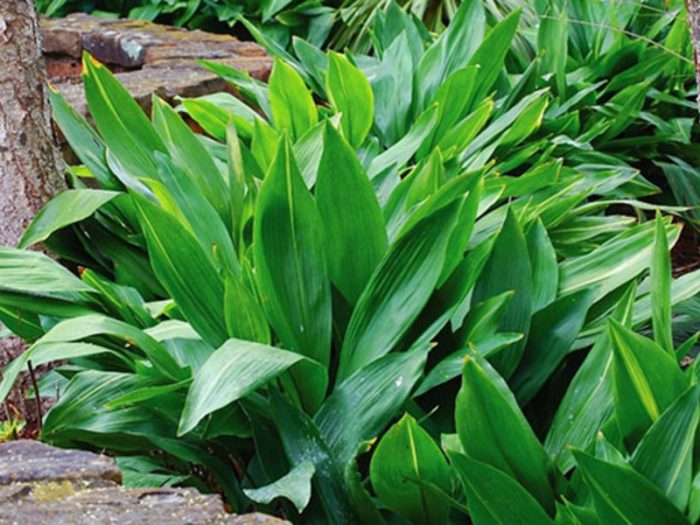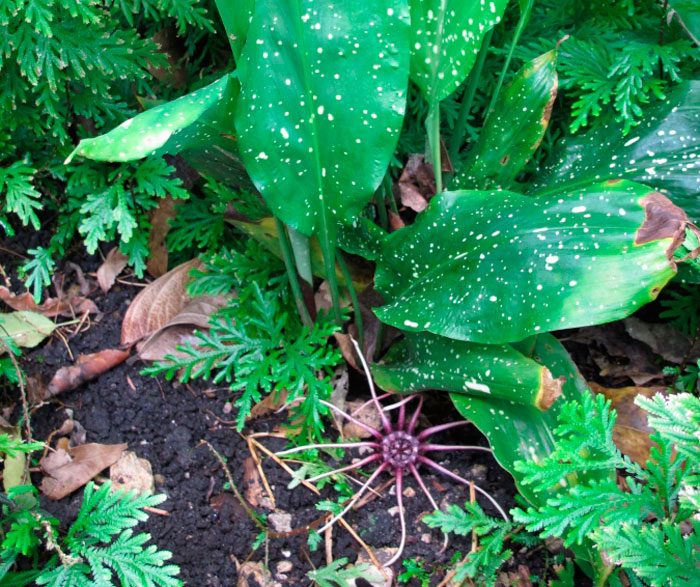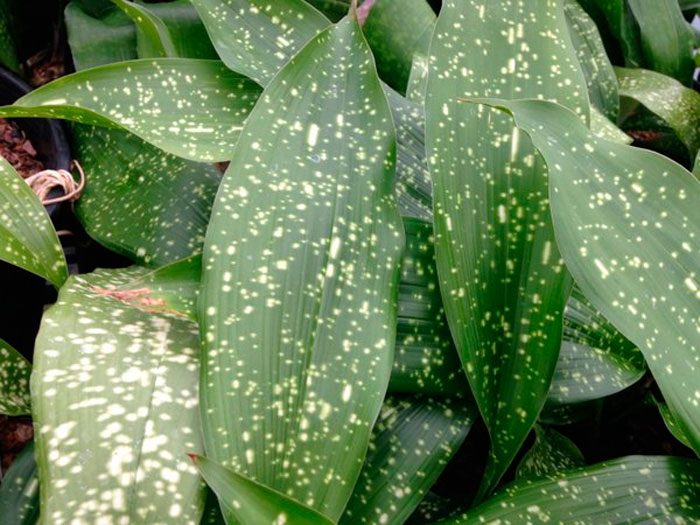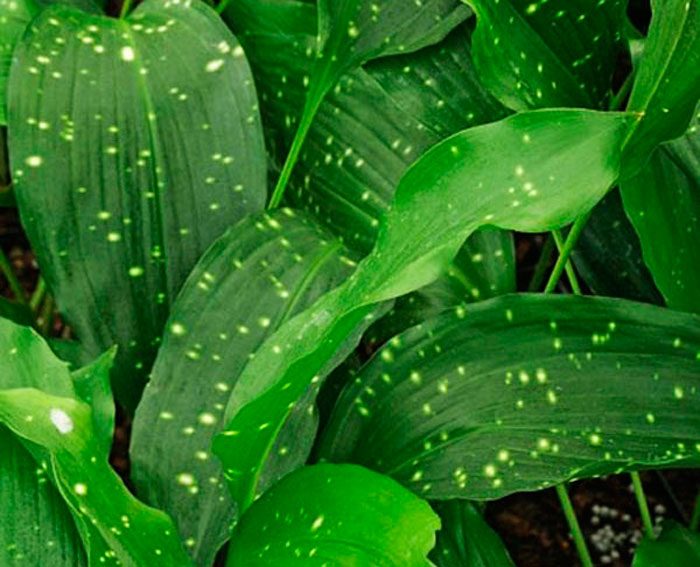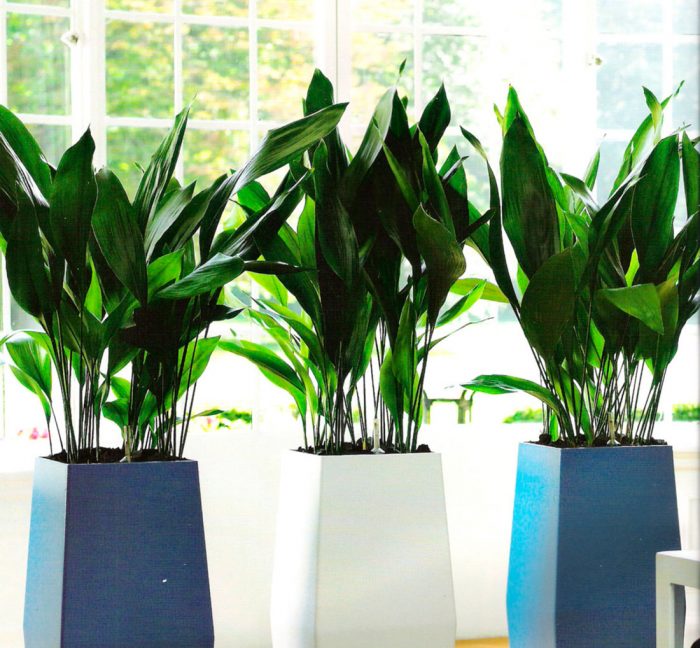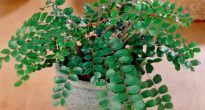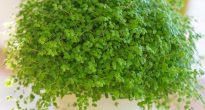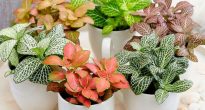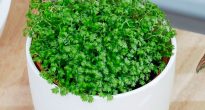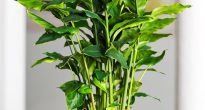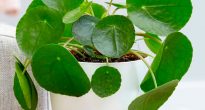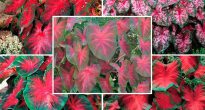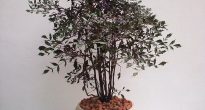The aspidistra plant is a perennial native to the tropical forests of East Asia. This plant is also called "snake pointer", this name is due to the fact that snakes often inhabit it. When they crawl through the bushes, they touch the foliage. In this regard, in the homeland of aspidistra, the rustle of its leaves is a sign that a poisonous predator is very close. This plant differs from others in its dense root system, the complete absence of stems, as well as bright green long leaf plates that have a smooth surface. Also, the flower is characterized by slow growth and very rare flowering. The bush can bloom only in the summer and only for one day. This plant is hardy, it grows well and develops in places with a polluted atmosphere. And it also tolerates the lack of light well, as well as the low air temperature in the room.
Content
Home care for aspidistra
Aspidistra is very popular with flower growers in many countries. The fact is that she does not differ in demanding care and does not need special conditions of detention. It is recommended to grow it for those beginner flower growers who are just taking their first steps in floriculture or who do not have enough free time to spend on a "capricious" plant.
Illumination
Most of the species of such a plant develop normally and grow even with poor lighting. In this regard, they can decorate even the most secluded corner of your apartment. But you should pay attention to the fact that species and varieties with striped foliage are more demanding on illumination and need a lot of light. If such a bush is placed in a shaded place, then after a while a spectacular pattern will disappear from its foliage. Also pay attention to the fact that in summer the plant must be reliably protected from direct sunlight.
Temperature regime
In the autumn-winter period, the optimum temperature for such a flower is 15-17 degrees. However, the lower air temperature will not harm the aspidistra, but even short-term frosts cannot be allowed.If the room is warmer, then this will also not do much harm to the plant, because it is able to quickly adapt to different levels of heat. However, if the room temperature is constantly above 20 degrees, then try to moisten the foliage from the sprayer as often as possible.
How to water
Watering such a plant is necessary only when necessary. Moistening the soil mixture in a pot is carried out only after its top layer dries. On average, in spring and summer, such a plant is watered twice or three times every 7 days. In the cold season, the number of irrigations is significantly reduced and they are carried out most often once every seven days. When organizing watering of aspidistra, it is necessary to take into account the fact that it can be significantly damaged by both overdrying of an earthen coma in a pot, and stagnation of liquid in the root system of the plant.
Suitable soil mixture
The plant develops normally and grows in simple soil collected in the garden. However, if you want it to develop as quickly as possible, then to plant it, you will need to purchase a universal soil mixture saturated with nutrients from a specialized store. If there is a desire, then you can make an earthen mixture with your own hands, for this you need to combine turf, river sand, dung humus and leafy soil in a ratio (2: 1: 2: 2).
Aspidistra transplant
The plant has a delicate and fragile root system that can be easily injured during transplantation. In this regard, experts do not advise to carry out transplants very often, as a rule, this is done once every 3 years. It is recommended to transplant a flower from one pot to another in March or April.
First, prepare a new pot, it should be slightly larger than the old container. Do not forget to make a good drainage layer at its bottom, expanded clay is perfect for this. The drainage layer must be sprinkled with a small amount of soil mixture. After that, carefully remove the plant from the container along with the clod of earth and transfer it to the prepared pot. Then fill any voids in a new pot with fresh potting soil and lightly compact the surface. The transplanted plant must be watered.
Top dressing
Aspidistra is fed only in the spring and summer. If the plant is grown in a place with poor lighting, then it is enough to apply fertilizer to the substrate only once every 3 months. If it grows in a well-lit place, then feeding is carried out 1 time in 4 weeks. For feeding, it is recommended to use water-soluble fertilizers for indoor flowers, which contain nitrogen in their composition. To feed such a plant, a nutrient solution is used, the concentration of which should be half that recommended by the manufacturer. Try not to flood the young foliage that has appeared on the root with the nutrient mixture during feeding.
Species and varieties with striped foliage do not need feeding. If you still feed them, then this will cause the pattern on the leaves to disappear.
Pruning
As it grows and ages, the bush loses its decorative effect. This can happen due to damage received, as well as when withered and dried foliage appears. They are a breeding ground for a variety of fungi and pests. In order to preserve the decorative effect of the flower, all those leaf plates that look unhealthy or have begun to dry out should be systematically removed. Cut the foliage carefully at the very root. Pruning helps not only to improve the general condition of the flower, but also stimulates the growth of new foliage.
Flowering features
When grown in indoor conditions, aspidistra bloom is extremely rare. For this to happen, it is necessary to provide the plant with the most suitable conditions for keeping.A distinctive feature of such flowering is that the formation of buds occurs on the roots. When the bud opens, a small, star-shaped, deep purple flower appears. The lifespan of one flower is only a day. When it withers, in its place is the formation of a round-shaped fruit, inside which a grain ripens.
Under natural conditions in tropical Asia, aspidistra blooms during the rainy season, which is observed in January – March. Indoor plant blooms in either spring or summer.
Wintering
The flower has an unusual ability to adapt to the cold, but it must be protected from frost. Also, the plant is kept in a place that is reliably protected from drafts. At the very beginning of spring, the bush must be fed, this will help it gain strength before the new growing season. Also, remember that if in winter the illumination is too poor, then this will have an extremely negative effect on the development and appearance of the flower.
Reproduction methods
Dividing the bush
The method of reproduction of aspidistra by dividing the bush is distinguished by its simplicity and efficiency. This procedure is carried out in the spring. Remove the bush from the pot and divide its root system into several parts. Make sure that each section has a rhizome and at least 5 leaf plates. Plant them in separate pots in a suitable substrate for such a plant. From above, they are covered with a transparent cap and removed to a cool (not higher than 18 degrees) and dark place. Delenki will be in such a place until a young leaf plate begins to grow on each of them, which is a sign that part of the bush has rooted successfully. In order to avoid the appearance of rot on the parcels, they are treated with wood ash before planting.
Reproduction by a sheet plate
A leaf cut from the main bush can also be used for propagation. This method takes more time, but it is highly efficient. Cut off the leaf plate, while the length of the petiole should be about 70 mm. After the cut is slightly dry, the leaf is placed in a bottle filled with water. Wrap the neck with tape so that there are no holes through which air could penetrate. The stalk is removed to a warm and well-lit place. In order to speed up rooting, it is recommended to add a growth stimulating agent to the water. After the appearance of the roots, the leaf plate is planted in a separate container filled with soil mixture, after which it is well watered. Until the young bush gets stronger, it is covered from above with a transparent cap, under which greenhouse conditions are created.
Possible problems
If the aspidistra is improperly looked after or not provided with suitable conditions for growth, this can cause various problems. For example:
- Wilting foliage... This can happen both as a result of overdrying a clod of earth, and because of stagnant liquid in the root system. In order to rectify the situation, it is necessary to revise the irrigation schedule.
- Yellowing leaves... This can be due to the natural aging of the plant, and also due to the fact that rot has appeared on the roots. If the plant has rotted, then you should temporarily suspend watering, and also treat the foliage with a solution of a fungicide preparation, and the substrate in a pot with a solution of manganese potassium.
- Drying of sheet plates... This occurs when the room is too hot or the humidity level is too low. In order to remedy the situation, more frequent watering of the bush is carried out, and it is also systematically moistened from a spray bottle.
- Foliage loses its spectacular color... This is observed when the flower is in a too dark place or if there are too many nutrients in the soil mixture.Move it to a well-lit place and do not feed it.
- Faded foliage... If the leaves of the flower become pale, it means that it does not have enough light, move it to a more illuminated place (the plant is gradually taught to a new level of illumination). The flower can be left in the same place, but in this case it is provided with additional lighting with fluorescent lamps.
- Leaves don't grow... This indicates a lack of nitrogen in the substrate. To accelerate the growth of the bush, it is recommended to pour a urea solution (1 gram of substance per 1 liter of water).
- Brown specks on leaf plates... They are formed both on the plate itself and on its edge. These are sunburns that appear when exposed to direct sunlight. Move the bush to a shaded area.
- Dark spots on the foliage surface... This suggests that the plant has been exposed to a draft or hypothermia has occurred.
- Infectious chlorosis... When the aspidistra is affected by such a disease, the yellowing of the foliage begins, the petals of the flowers turn green and, in general, the color of the bush changes. The affected plant must be destroyed as soon as possible.
- Red spider mite... This small pest is very dangerous for the flower. In the affected bush, a large number of light-colored spots form on the front surface of the foliage, while a white cobweb can be found on the seamy side of the plate. Wash the foliage on both sides with a soap solution.
- Palm scale... Such a very small insect feeds on plant sap, which it sucks from the foliage of the plant. If a whole colony settles on a bush, then because of this, the foliage may begin to turn yellow and die off. If scale insects are found, they are manually removed from the surface of the leaves, and then the bush is washed with clean water.
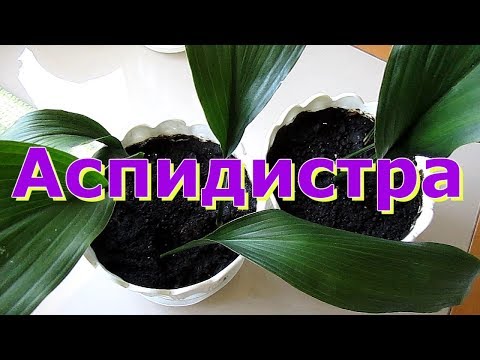

Watch this video on YouTube
Types and varieties of aspidistra with photos and names
Aspidistra high (Elatior)
The name of this species is due to the fact that the bush is relatively large. Under natural conditions, it can reach a height of about 0.8 meters. When grown indoors, the height of such a flower, as a rule, varies from 0.6 to 0.7 m. The length of the leaf plates is about 0.3-0.5 m, and their width is 0.1-0.15 m, they have an oblong-pointed shape (outwardly similar to "sharp tongues"). Their surface is glossy, and their color is green. Over time, the shrub grows, becomes thick and something like a lush fountain. This species is characterized by extremely slow development. Within 12 months only 3-5 new leaf plates grow on the bush. When grown indoors, flowering occurs very rarely and only in summer. Small purple-red flowers form on the bush, reaching no more than 30 mm in diameter.
Aspidistra Milky Way
Such an evergreen plant in height can reach from 0.4 to 0.6 m. If foliage growth is not limited, then the shrub can become thick and large in diameter. This plant is highly drought tolerant, and it is able to withstand not very large cold snaps. The surface of the long, rigid leaf plates is decorated with a large number of cream spots. Such points are like small stars, which are countless in the sky. This color was the reason for choosing just such a name for this species, the fact is that "Milky Way" is translated as "Milky Way". This plant, like other aspidistra, is slow-growing, and it blooms quite rarely. When grown indoors, flowering is observed in the last winter or first spring weeks. Small purple flowers with sharp petals grow on the bush.
Aspidistra variegated
This species reaches a height of about half a meter. Over time, it can grow a lot, resulting in a dense bush.It differs from other species in its greater demand for care, for normal growth and development, it needs to provide an optimal level of lighting and humidity, as well as timely feeding. Vertically arranged cream stripes adorn the dark green leaf plates. If the plant is kept incorrectly, then these very stripes may disappear from it. This happens due to excessively high moisture content of the substrate in the pot or as a result of excess fertilizing.
Aspidistra blume
Large glossy leaf plates of such a perennial are painted dark green. Their shape is similar to the foliage of a lily of the valley, but they are much larger, for example, they reach about 50 centimeters in length and up to 15 centimeters in width. Differs in rare flowering. A flower is formed at the very rhizome. There are 8 petals in the bud, painted in crimson or yellow.
Aspidistra attenuate
In this evergreen plant, leaf plates have long petioles (up to 30 centimeters), and their length can reach half a meter. There are many small white spots on their surface. This species, like many others, is characterized by undemanding care. It is very hardy and therefore grows well in cool climates in places with gassed air. Over time, the bush grows and becomes lush. A small purple flower grows at the base of the rhizome once a year in the first summer weeks. After opening the bud, the flower reaches about 30 mm in diameter.
Aspidistra grandiflorum
This species was discovered relatively recently. This plant is becoming more and more popular with flower growers every year. Its distinctive features are large flowers and long (about 0.8 m) oval leaf plates. It also differs from other species in that it does not form a lush bush over time. In indoor conditions, the bush rarely blooms, as a rule, this occurs in the middle of the summer period. 3-5 buds are formed on the main root, and of them dark purple flowers appear. After opening the bud, the flower reaches 50 mm in diameter. Unusually shaped long petals are outwardly similar to spider legs.
Aspidistra sichuan
In nature, the species can be found in China in bamboo forests at an altitude of 700 meters above sea level. In these places, such aspidistra prefers to grow in the fields, it covers the entire territory with its lush leaves. When grown indoors, the bush also becomes a dense shrub over time. It has oval straight leaf plates, which are about 30 centimeters long and up to 8 centimeters wide. The surface of the foliage is decorated with arcuate longitudinal white stripes. The bush blooms in the spring. One bud is formed on the main root, and from it a small flower of dark purple color appears.
Aspidistra oblantsefolia
The leaf plates of this type are green and narrow (no more than 30 mm wide). It has varieties that have yellow blotches on the foliage. The total height of the bush is about 0.6 m. In this species, during flowering, small red star-shaped flowers appear, their disclosure begins in the first spring weeks.
Aspidistra Guanjou
This species differs from others in that its short (up to 20 centimeters long) leaf plates have long petioles, the height of which is about 40 centimeters. On the surface of dense and wide leaf plates, there are specks of yellowish color. Flowering begins in May, at this time paired buds form on thin roots, and then large flowers appear from them, very similar to those that are formed in large-flowered aspidistra. The opened flowers are purple or purple in color.
The healing properties of aspidistra
People living in East Asia have known for a long time that aspidistra has medicinal properties. Therefore, it is often used in alternative medicine.For example, if the gums are bleeding, it is recommended to chew the fresh foliage of the plant. A fresh leaf of aspidistra is applied to a hematoma or a small wound on the skin.
The substances included in the flower have a hemostatic and disinfecting effect, and they also reduce swelling. A decoction of such a plant is used for diseases of the stomach and intestines, cystitis, diarrhea and sore throat.
Toning tincture: 1 tbsp. lukewarm water is combined with 1 tbsp. l. chopped aspidistra foliage. An hour later, the infusion will be ready, it will only be necessary to strain it. The remedy is drunk for three days, a couple of tablespoons in the morning and at lunchtime.
Remedy for periodontitis: cut off a leaf of aspidistra, rinse it in boiled water and slowly chew it until mushy. Wait a minute and spit out the resulting mass. The procedure is carried out once every 2 hours. If everything is done correctly, the inflammation will quickly go away, and the state of health will improve significantly.
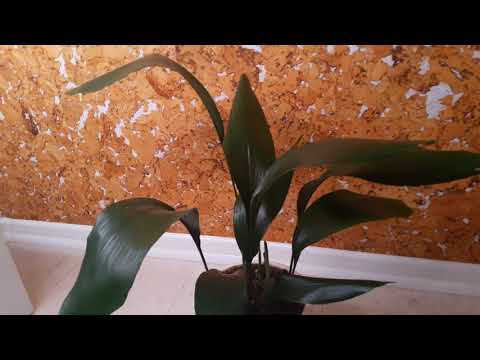

Watch this video on YouTube


